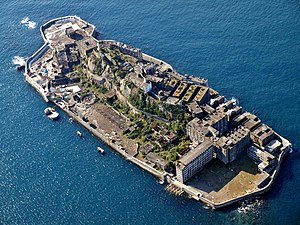Hashima Island, Japan.




Hashima island in Japan has a wide array of nicknames, including Battelship Island (for its shape) and Ghost Island. From the late 1800s to late 1900s, the island was populated because of the access it granted to undersea coal mines. However, as Japan gradually switched from coal to petroleum, the mines (and the buildings that sprung up around them to support their workers) closed down, leaving an isolated ghost town that reminds some of a ghostly concrete battleship. It’s a seriously creepy and mysterious place.
| Native name: 端島 Nickname: Battleship Island | |
|---|---|

Aerial view
| |
 | |
| Geography | |
| Location | Northeast Asia |
| Area rank | none |
| Administration | |
| Prefecture | Nagasaki Prefecture |
| Demographics | |
| Population | 0 (2016) |
Hashima Island (端島 or simply Hashima — -shima is a Japanese suffix for island), commonly called Gunkanjima (軍艦島; meaning Battleship Island), is an abandoned island lying about 15 kilometers (9 miles) from the city of Nagasaki, in southern Japan. It is one of 505 uninhabited islands in Nagasaki Prefecture. The island's most notable features are its abandoned concrete buildings, undisturbed except by nature, and the surrounding sea wall. While the island is a symbol of the rapid industrialization of Japan, it is also a reminder of its dark history as a site of forced labor prior to and during the Second World War.
The 6.3-hectare (16-acre) island was known for its undersea coal mines, established in 1887, which operated during the industrialization of Japan. The island reached a peak population of 5,259 in 1959. In 1974, with the coal reserves nearing depletion, the mine was closed and all of the residents departed soon after, leaving the island effectively abandoned for the following three decades. Interest in the island re-emerged in the 2000s on account of its undisturbed historic ruins, and it gradually became a tourist attraction of a sort. Certain collapsed exterior walls have since been restored, and travel to Hashima was re-opened to tourists on April 22, 2009. Increasing interest in the island resulted in an initiative for its protection as a site of industrial heritage.
The island was formally approved as a UNESCO World Heritage site in July 2015, as part of Japan's Sites of Japan’s Meiji Industrial Revolution: Iron and Steel, Shipbuilding and Coal Mining.
Credited From www.smash.com and en.wikipedia.org
Mga Komento
Mag-post ng isang Komento